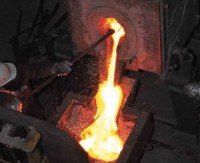Steel Futures Market Auto Suppliers' Savior?
High material costs (particularly steel) are wreaking havoc on automotive suppliers, caught between soaring raw materials costs and cost-cutting customers. But the industry is getting a new tool which could help iron-out the most precipitous jumps in steel prices. Automotive News [sub] reports that the New York Mercantile Exchange will introduce a futures market for domestic hot-rolled coil steel this fall. The move could provide more price predictability for the crucial commodity. "The NYMEX proposal is one more option that we will review in determining the most appropriate overall strategy for us," GM spokesfolks didn't reveal. Steelmakers are not thrilled by the plan. They prefer the current method of direct price negotiation, and warn that speculators could drive prices up (it's hard to believe things could be much worse than the doubling of steel prices since December). Steel mill profits have been strong during the period of price increases, and the bankruptcies which once riddled steel production have migrated to steel customers, particularly auto parts suppliers. Though speculation is always a concern, a competitive futures market typically stabilizes market prices and makes downstream contract negotiations far easier.
More by Edward Niedermeyer


































Comments
Join the conversation
I believe the key here is predictability. With a futures market in steel, nobody will be caught off-guard when the price gains [s]25% [/s][s]50% 100%[/s] 1000% in 12 months.
Eh futures regulate the market somewhat, but far more importantly they allow one to lock in prices. Even more importantly they allow smart companies to hedge their prices. Southwest did this to maintain profitability even as fuel prices rose to untold amounts. There are also advantages of demand streamlining etc.
@Samir: The difference is that steel isn't a limited resource, lots of appropriate rocks in the ground, and the scrap is 100% recyclable. Price stability might have staved off the worst of the steel bankruptcies of the late 90's. That would have left more of the domestic mills in the hands of domestic management. Yay us! That would also have left more of the domestic mills in the hands of somewhat flaccid management. Hmmmm.... I can argue both sides of that.
It's not the raw material, but the energy and transportation costs that are driving up steel prices. The problem with steel (even recycled scrap) is that the "cheap" import market has reduced domestic basic steel manufacturing to a trickle (compared to the 1970's). Now that now that transportation costs are getting high, there's no domestic capacity to take advantage of the higher costs of imports; we're still exporting steel scrap to China (and others) because we can't cook the stuff fast enough to meet domestic demand (so the price soars). This could lead to a small resurgence of the industry, which could stabilize prices.